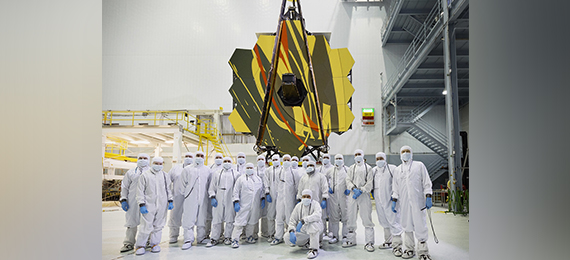
NASA’s James Webb telescope is all set to reach L2, its final destination. Find out fascinating details about this $10 million telescope now with a quiz game.
When Was The James Webb Telescope Launched?
The James Webb Telescope (JSWT) was launched from French Guiana, Europe’s Spaceport, on December 25, 2021. The telescope will orbit around its final destination L2 for a period of 20 years. It will collect data on new skylines from various focal points that were not visible previously.
Webb Space Telescope’s Million Mile Journey
L2, the James Webb telescope’s final destination, is situated 1.5 million kilometers away from earth. L2, the second Lagrange point. A Lagrange point helps spacecraft stay in a position without consuming too much fuel. There are currently 5 Lagrange points between the Sun and the Earth. The points are set based on the gravitational force that exists between two celestial bodies.
Can NASA’s James Webb Telescope See the Past?
- A. Yes
- B. No
James Webb Telescope at Its Final Destination
The thrusters will be fired on January 24th at 2.00 pm ET. NASA’s recent tweet said that the thrusters will be fired every three weeks. This will ensure the JSWT will stay in line with the Earth while orbiting the sun every six months at L2.
NASA said it will take months to arrange the 18 hexagonal mirrors within the JWST to receive clear images. The Northrop Grumman group funded the $10 billion project. NASA’s James Webb Space Telescope was initially quoted for $500 million. It took more than 2 decades to test every possibility that can result in a crash before launch.
James Webb Telescope Facts
- NASA chose L2 as the anchorage point because the temperature would best suit the telescope year around. The infrared observatory needs to be hotter than Earth’s room temperature.
- The telescope’s equipment will also need a cooler place than the vacant Lagrange points near the sun. The earth and the moon both will remain at one side of space at any given time during the telescope’s operation. This will ensure shade.
- L1 is currently occupied by SOHO (Solar and Heliospheric Observatory)
- JSWT can see around 13.7 billion light-years. It will need a couple of months to travel to a new focal point at the L2 range.
- The telescope will be able to collect data about the Universe 100 million years after the Big Bang from the L2 point. It’s 100 times more powerful than the Hubble telescope.
- The JSWT is made of beryllium and less than 2 ounces of gold.
- It carries the largest lightweight mirrors in history.
- The internal temperature should be cold enough to sustain nitrogen in liquid form.
- Robots can be used to refuel the telescope at the end of its lifespan but NASA isn’t planning to do so.